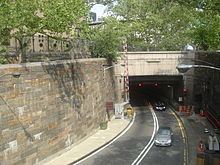Other name(s) Queens–Midtown Tunnel Crosses East River No. of lanes 4 Opened 15 November 1940 Operator MTA Bridges and Tunnels Architect Ole Singstad | Route 4 lanes of I-495 Traffic 79,063 (2010) Total length 1,955 m Body of water East River Location Manhattan, Queens | |
 | ||
Toll As of March 19, 2017, $8.50 (Tolls by Mail); $5.76 (New York E-ZPass) Similar Brooklyn–Battery Tunnel, Triborough Bridge, Bronx–Whitestone Bridge, Throgs Neck Bridge, Lincoln Tunnel | ||
The Queens–Midtown Tunnel (sometimes simply known as the Midtown Tunnel) is a highway, tunnel and toll road in New York City. It crosses under the East River and connects the Borough of Queens (at the Long Island City terminus of the Long Island Expressway) on Long Island, with the borough of Manhattan (between the major crosstown thoroughfares of East 34th Street and East 42nd Street in the Midtown Manhattan area). Designed by Ole Singstad, it was opened to traffic on November 15, 1940. The tunnel consists of twin tubes carrying four traffic lanes, and is 6,414 feet (1,955 m) long. It once carried New York State Route 24. The tunnel is owned by New York City and operated by MTA Bridges and Tunnels, an affiliate agency of the Metropolitan Transportation Authority.
Contents
Map of Queens Midtown Tunnel, New York, NY, USA
History
When planning began, a bridge was strongly supported by some backers, including Robert Moses, who balked at the increased cost of a tunnel and the fact that it would not be completed in time for the 1939 World's Fair. Manhattan borough president Samuel Levy in particular was a strong backer of a six-lane bridge plan. Commissioner William Friedman of the New York City Tunnel Authority rejected the alternative outright. The Ole Singstad-designed tunnel was opened to traffic on November 15, 1940.
From 1981 to 2011, the tunnel was closed to traffic for a few hours one night each spring to allow for the annual Ringling Bros. and Barnum & Bailey Circus Animal Walk. Several nights before the circus opened at Madison Square Garden, the elephants marched into Manhattan and down 34th Street to the arena. While this event was a much anticipated annual tradition for some, in recent years it attracted organizations protesting the treatment of the circus animals. When the circus moved to the Barclays Center in 2012, the elephant walk through the tunnel ceased.
In the 1997 feature film Men in Black, Tommy Lee Jones and Will Smith star in a scene in which their Ford LTD car rides upside down on the ceiling of the tunnel.
Bus routes
The tunnel carries 23 express bus routes; twenty of these routes use the tunnel for westbound travel only. The bus routes that use the tunnel are the BM5, QM1, QM2, QM3, QM4, QM5, QM6, QM7, QM8, QM10, QM11, QM12, QM15, QM16, QM17, QM18, QM24, QM25, all operated by the MTA Bus Company, and the X63, X64, X68 operated by MTA New York City Transit. All of these routes except the BM5, QM7, QM8, QM11 and QM25 use the tunnel for westbound travel only, as most of the routes use the Queensboro Bridge for eastbound travel.
Tolls
Starting on March 19, 2017, drivers will pay $8.50 per car or $3.50 per motorcycle for tolls by mail. E‑ZPass users with transponders issued by the New York E‑ZPass Customer Service Center pay $5.76 per car or $2.51 per motorcycle. All E-ZPass users with transponders not issued by the New York E-ZPass CSC will be required to pay cash toll/Toll-by-mail rates.
Open-road cashless tolling started on January 10, 2017 at 3 am. The tollbooths will be gradually dismantled, and drivers will no longer be able to pay cash at the tunnel. Instead, there will be cameras mounted onto new overhead gantries near where the booths are currently located. Drivers without E-ZPass will have a picture of their license plate taken, and the toll will be mailed to them. For E-ZPass users, sensors will detect their transponders wirelessly.
